A Mid-Infrared Multifunctional Optical Device Based on Fiber Integrated Metasurfaces
Abstract
:1. Introduction
2. Structure Design and Simulation Setup
3. Simulation Results and Discussion
3.1. Theoretical Analysis and Simulation of HC-ARF
3.2. Theoretical Analysis and Simulation of Si3N4 Metasurface
3.2.1. Single-layer Si3N4 Metasurface
3.2.2. Bilayer Si3N4 Metasurface
4. Conclusions
Author Contributions
Funding
Data Availability Statement
Conflicts of Interest
References
- Yang, C.; Wang, Z.; Yuan, H.; Li, K.; Zheng, X.; Mu, W.; Yuan, W.; Zhang, Y.; Shen, W. All-Dielectric Metasurface for Highly Tunable, Narrowband Notch Filtering. IEEE Photonics J. 2019, 11, 1–6. [Google Scholar] [CrossRef]
- Zhang, J.; Yu, X.; Dong, J.; Yang, W.; Liu, S.; Shen, C.; Duan, J.; Deng, X. A Plasmonic Infrared Multiple-Channel Filter Based on Gold Composite Nanocavities Metasurface. Nanomaterials 2021, 11, 1824. [Google Scholar] [CrossRef] [PubMed]
- Dudek, M.; Kowerdziej, R.; Pianelli, A.; Parka, J. Graphene-based tunable hyperbolic microcavity. Sci. Rep. 2021, 11, 74. [Google Scholar] [CrossRef]
- Abu Aisheh, M.; Abutoama, M.; Abuleil, M.J.; Abdulhalim, I. Fast tunable metamaterial liquid crystal achromatic waveplate. Nanophotonics 2023, 12, 1115–1127. [Google Scholar] [CrossRef]
- Wang, Y.; Yu, S.; Gao, Z.; Song, S.; Li, H.; Zhao, T.; Hu, Z. Excitations of Multiple Fano Resonances Based on Permittivity-Asymmetric Dielectric Meta-Surfaces for Nano-Sensors. IEEE Photonics J. 2022, 14, 1–7. [Google Scholar] [CrossRef]
- Tu, S.; Liu, X.; Liang, K.; Fu, Q.; Wang, Y.; Du, Q.; Li, Z. An ultra-high figure of merit refractive index sensor with Mie lattice resonance of a toroidal dipole in an all-dielectric metasurface array in the near-infrared. J. Phys. D Appl. Phys. 2023, 56, 115101. [Google Scholar] [CrossRef]
- Yuan, L.; Qiu, C.; Liao, Z.; Gong, M.; Long, Y.; Yang, R.; Zhang, Z. Nanoscale refractive index sensor with ultrahigh figure of merit based on toroidal dielectric metasurfaces. Opt. Commun. 2023, 528, 128988. [Google Scholar] [CrossRef]
- Guo, L.; Zhang, Z.; Xie, Q.; Li, W.; Xia, F.; Wang, M.; Feng, H.; You, C.; Yun, M. Toroidal dipole bound states in the continuum in all-dielectric metasurface for high-performance refractive index and temperature sensing. Appl. Surf. Sci. 2023, 615, 156408. [Google Scholar] [CrossRef]
- Zhu, W.; Guo, L.; Du, K.; Zhang, B.; Zhou, C.; Chen, G.; Bai, J.; Xu, M.; Wang, S. Continuously controlling the phase transition of In3SbTe2 for tunable high quality-factors absorber. Opt. Laser Technol. 2023, 162, 109239. [Google Scholar] [CrossRef]
- Mi, Q.; Sang, T.; Pei, Y.; Yang, C.; Li, S.; Wang, Y.; Ma, B. High-quality-factor dual-band Fano resonances induced by dual bound states in the continuum using a planar nanohole slab. Nanoscale Res. Lett. 2021, 16, 150. [Google Scholar] [CrossRef]
- Zhou, J.; Huang, L.J.; Fu, Z.Y.; Sun, F.J.; Tian, H.P. Multiplexed Simultaneous High Sensitivity Sensors with High-Order Mode Based on the Integration of Photonic Crystal 1 × 3 Beam Splitter and Three Different Single-Slot PCNCs. Sensors 2016, 16, 1050. [Google Scholar] [CrossRef] [PubMed]
- Su, H.; Cheng, X.R.; Endo, T.; Kerman, K. Photonic crystals on copolymer film for label-free detection of DNA hybridization. Biosens. Bioelectron. 2018, 103, 158–162. [Google Scholar] [CrossRef]
- Huang, Q.L.; Peh, J.; Hergenrother, P.J.; Cunningham, B.T. Porous photonic crystal external cavity laser biosensor. Appl. Phys. Lett. 2016, 109, 071103. [Google Scholar] [CrossRef]
- Sana, A.K.; Amemiya, Y.; Ikeda, T.; Kuroda, A.; Yokoyama, S. Detection of Prostate Specific Antigen Using Silicon Photonic Crystal Nanocavity Resonator. In Proceedings of the Conference on Quantum Sensing and Nano Electronics and Photonics XIV, San Francisco, CA, USA, 29 January–2 February 2017. [Google Scholar]
- Shuai, Y.; Zhao, D.; Singh Chadha, A.; Seo, J.-H.; Yang, H.; Fan, S.; Ma, Z.; Zhou, W. Coupled double-layer Fano resonance photonic crystal filters with lattice-displacement. Appl. Phys. Lett. 2013, 103, 241106. [Google Scholar] [CrossRef]
- Shuai, Y.; Zhao, D.; Tian, Z.; Seo, J.H.; Plant, D.V.; Ma, Z.; Fan, S.; Zhou, W. Double-layer Fano resonance photonic crystal filters. Opt. Express 2013, 21, 24582–24589. [Google Scholar] [CrossRef]
- Yang, Y.; Wang, Z.; Sun, F.; Tian, H. Modeling and design of a coupled PhC slab sensor for simultaneous detection of refractive index and temperature with strong anti-interference ability. Opt. Express 2020, 28, 22151–22164. [Google Scholar] [CrossRef]
- Liu, Y.; Zhou, W.; Sun, Y. Optical Refractive Index Sensing Based on High-Q Bound States in the Continuum in Free-Space Coupled Photonic Crystal Slabs. Sensors 2017, 17, 1861. [Google Scholar] [CrossRef]
- Wang, Z.; Wang, C.; Sun, F.; Fu, Z.; Xiao, Z.; Wang, J.; Tian, H. Double-layer Fano resonance photonic-crystal-slab-based sensor for label-free detection of different size analytes. J. Opt. Soc. Am. B 2019, 36, 215–222. [Google Scholar] [CrossRef]
- Pors, A.; Nielsen, M.G.; Eriksen, R.L.; Bozhevolnyi, S.I. Broadband focusing flat mirrors based on plasmonic gradient metasurfaces. Nano Lett. 2013, 13, 829–834. [Google Scholar] [CrossRef]
- Zheng, Z.; Komar, A.; Zangeneh Kamali, K.; Noble, J.; Whichello, L.; Miroshnichenko, A.E.; Rahmani, M.; Neshev, D.N.; Xu, L. Planar narrow bandpass filter based on Si resonant metasurface. J. Appl. Phys. 2021, 130, 053105. [Google Scholar] [CrossRef]
- Ni, X.; Ishii, S.; Kildishev, A.V.; Shalaev, V.M. Ultra-thin, planar, Babinet-inverted plasmonic metalenses. Light Sci. Appl. 2013, 2, e72. [Google Scholar] [CrossRef]
- Kapron, F.P.; Keck, D.B.; Maurer, R.D. Radiation Losses in Glass Optical Waveguides. Appl. Phys. Lett. 1970, 17, 423–425. [Google Scholar] [CrossRef]
- Fu, D.X.; Zhang, Y.N.; Zhang, A.Z.; Han, B.; Wu, Q.L.; Zhao, Y. Novel Fiber Grating for Sensing Applications. Phys. Status Solidi A Appl. Mater. Sci. 2019, 216, 1800820. [Google Scholar] [CrossRef]
- Xavier, G.B.; Lima, G. Quantum information processing with space-division multiplexing optical fibres. Commun. Phys. 2020, 3, 9. [Google Scholar] [CrossRef]
- Zhao, Q.; Yuan, W.; Qu, J.; Cheng, Z.; Peng, G.D.; Yu, C. Optical Fiber-Integrated Metasurfaces: An Emerging Platform for Multiple Optical Applications. Nanomaterials 2022, 12, 793. [Google Scholar] [CrossRef]
- Vaiano, P.; Carotenuto, B.; Pisco, M.; Ricciardi, A.; Quero, G.; Consales, M.; Crescitelli, A.; Esposito, E.; Cusano, A. Lab on Fiber Technology for biological sensing applications. Laser Photonics Rev. 2016, 10, 922–961. [Google Scholar] [CrossRef]
- Kim, M.; Park, N.-R.; Yu, A.; Kim, J.T.; Jeon, M.; Jeon, S.-W.; Han, S.-W.; Kim, M.-K. Multilayer all-polymer metasurface stacked on optical fiber via sequential micro-punching process. Nanophotonics 2023, 12, 13. [Google Scholar] [CrossRef]
- Luo, Z.; Zhang, W.; Song, N.; Chen, D.; Deng, S.; Liu, H.; Ming, C.; Yuan, L.; Deng, H. Fiber-integrated catenary ring-array metasurfaces for beam shaping. Opt. Lett. 2023, 48, 25–28. [Google Scholar] [CrossRef]
- Xu, J.; Liu, K.; Sang, Y.; Tan, Z.; Guo, C.; Zhu, Z. Millimeter-scale ultrathin suspended metasurface integrated high-finesse optomechanical cavity. Opt. Lett. 2022, 47, 5481–5484. [Google Scholar] [CrossRef]
- Litchinitser, N.M.; Abeeluck, A.K.; Headley, C.; Eggleton, B.J. Antiresonant reflecting photonic crystal optical waveguides. Opt. Lett. 2002, 27, 1592–1594. [Google Scholar] [CrossRef]
- Poletti, F. Nested antiresonant nodeless hollow core fiber. Opt. Express 2014, 22, 23807–23828. [Google Scholar] [CrossRef] [PubMed]
- Yu, F.; Song, P.; Wu, D.; Birks, T.; Bird, D.; Knight, J. Attenuation limit of silica-based hollow-core fiber at mid-IR wavelengths. APL Photonics 2019, 4, 080803. [Google Scholar] [CrossRef]
- Uebel, P.; Gunendi, M.C.; Frosz, M.H.; Ahmed, G.; Edavalath, N.N.; Menard, J.M.; Russell, P.S. Broadband robustly single-mode hollow-core PCF by resonant filtering of higher-order modes. Opt. Lett. 2016, 41, 1961–1964. [Google Scholar] [CrossRef] [PubMed]
- Fu, T.; Zhou, Z.Q.; Wang, D.F.; Yang, T.B.; Li, H.O.; Chen, Y.H. Electromagnetically induced transparency based on magnetic toroidal mode of dielectric reverse-symmetric spiral metasurfaces. New J. Phys. 2022, 24, 033024. [Google Scholar] [CrossRef]
- Tagouegni, S.; Fotsa-Ngaffo, F.; Kenfack-Jiotsa, A. Non-Hermitian electronics multipods of electromagnetically induced transparency (EIT) and absorption (EIA). Opt. Quantum Electron. 2022, 54, 200. [Google Scholar] [CrossRef]
- Yang, Y.; Kravchenko, I.I.; Briggs, D.P.; Valentine, J. All-dielectric metasurface analogue of electromagnetically induced transparency. Nat. Commun. 2014, 5, 5753. [Google Scholar] [CrossRef]
- Papasimakis, N.; Fedotov, V.A.; Savinov, V.; Raybould, T.A.; Zheludev, N.I. Electromagnetic toroidal excitations in matter and free space. Nat. Mater. 2016, 15, 263–271. [Google Scholar] [CrossRef]
- Li, H.; Xing, J.; Shi, Y.; Yu, S.; Zhao, T. Performance analysis and optimization of high Q-factor toroidal resonance refractive index sensor based on all-dielectric metasurface. Opt. Laser Technol. 2023, 157, 108752. [Google Scholar] [CrossRef]
- Li, J.; Xu, M.; Liu, J.; Li, H.; Song, H.; Zhou, A. Theoretical analysis of a highly sensitive SPR temperature sensor based on Ag/TiO2 hyperbolic metamaterials and PDMS film. Opt. Laser Technol. 2022, 156, 108610. [Google Scholar] [CrossRef]
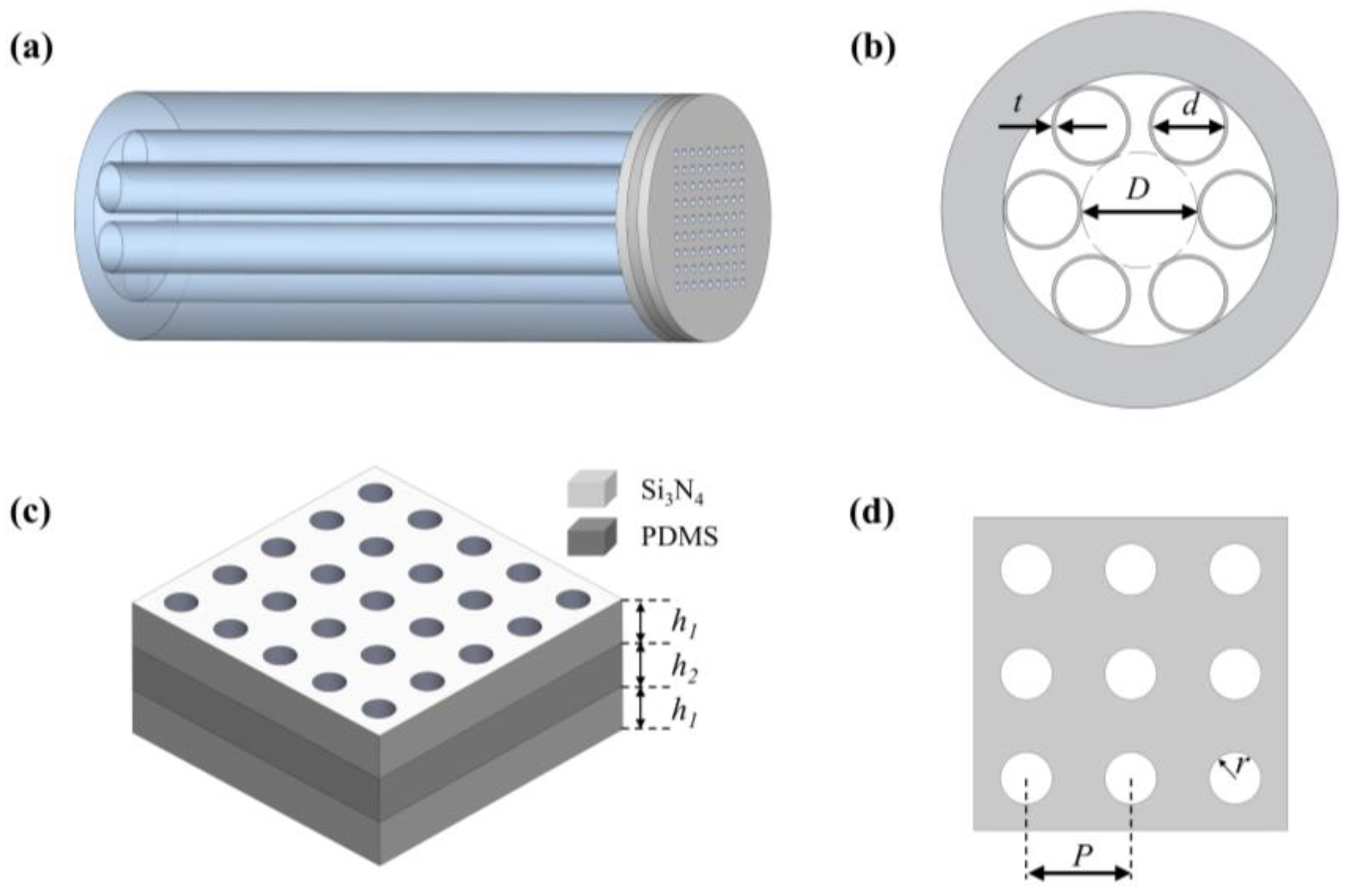
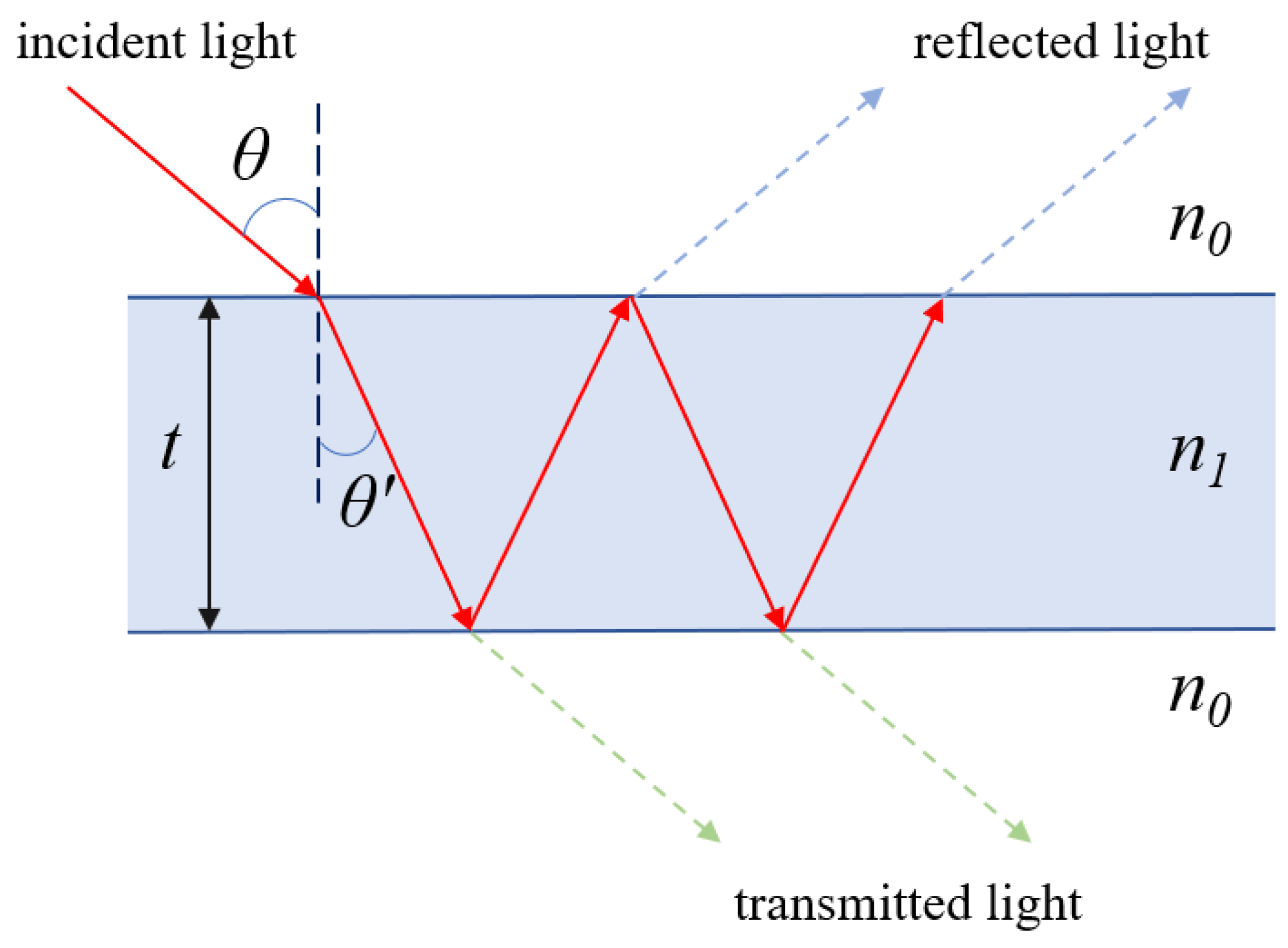
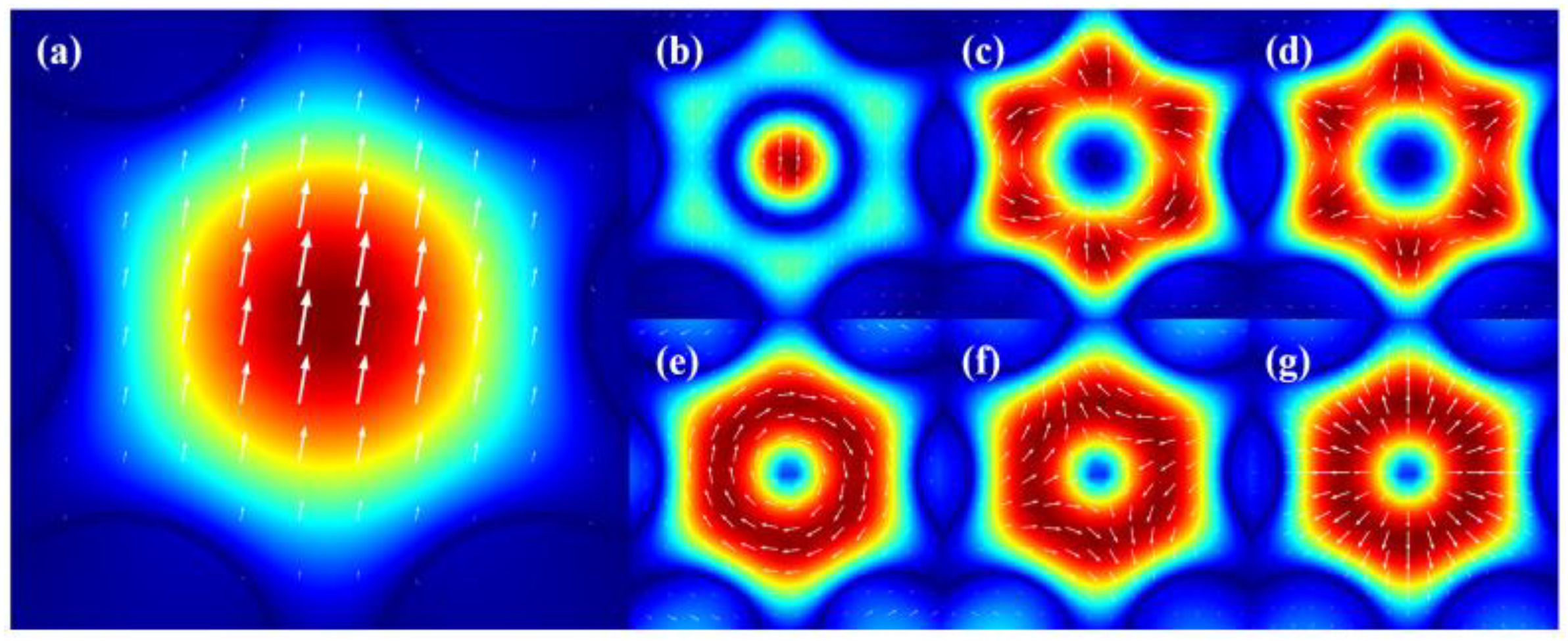
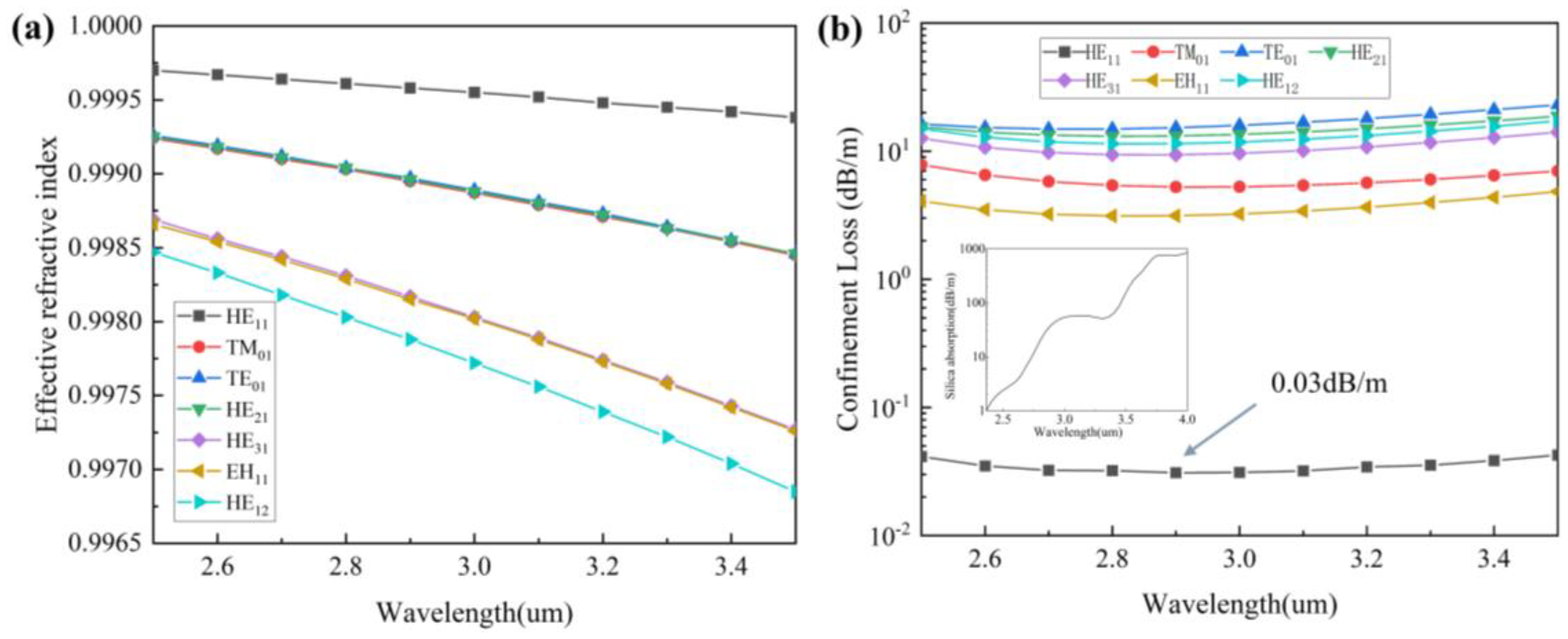

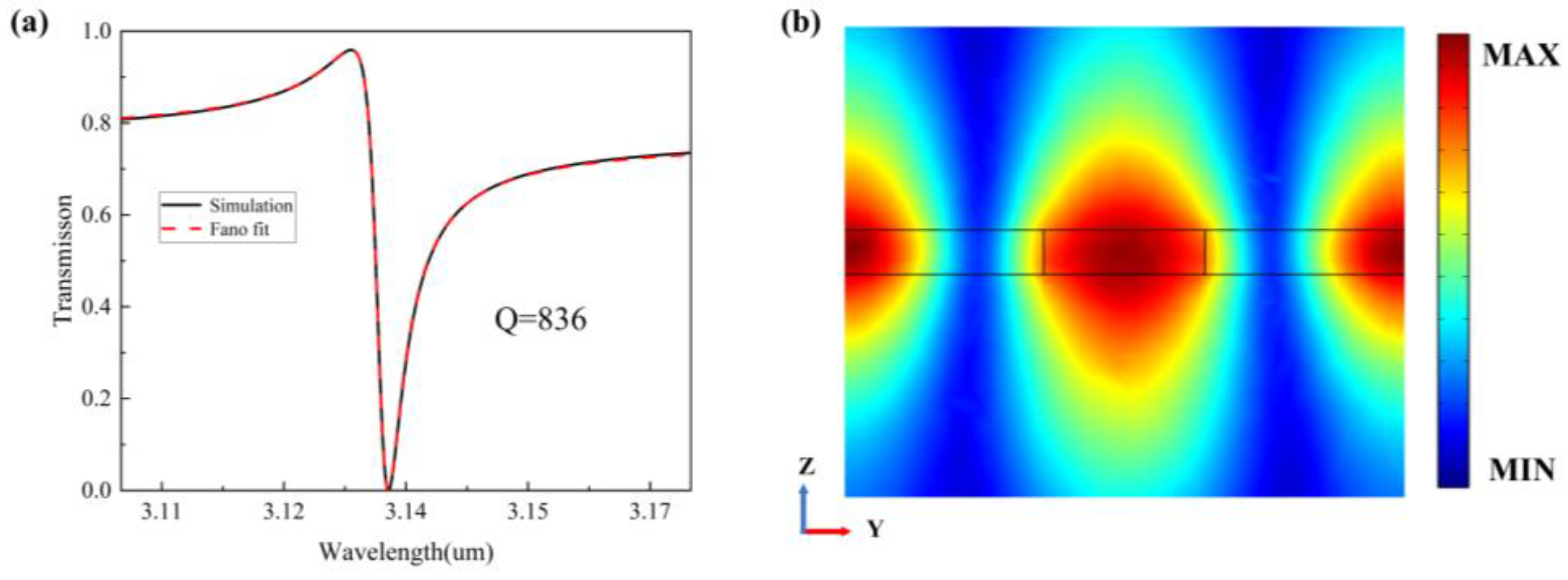
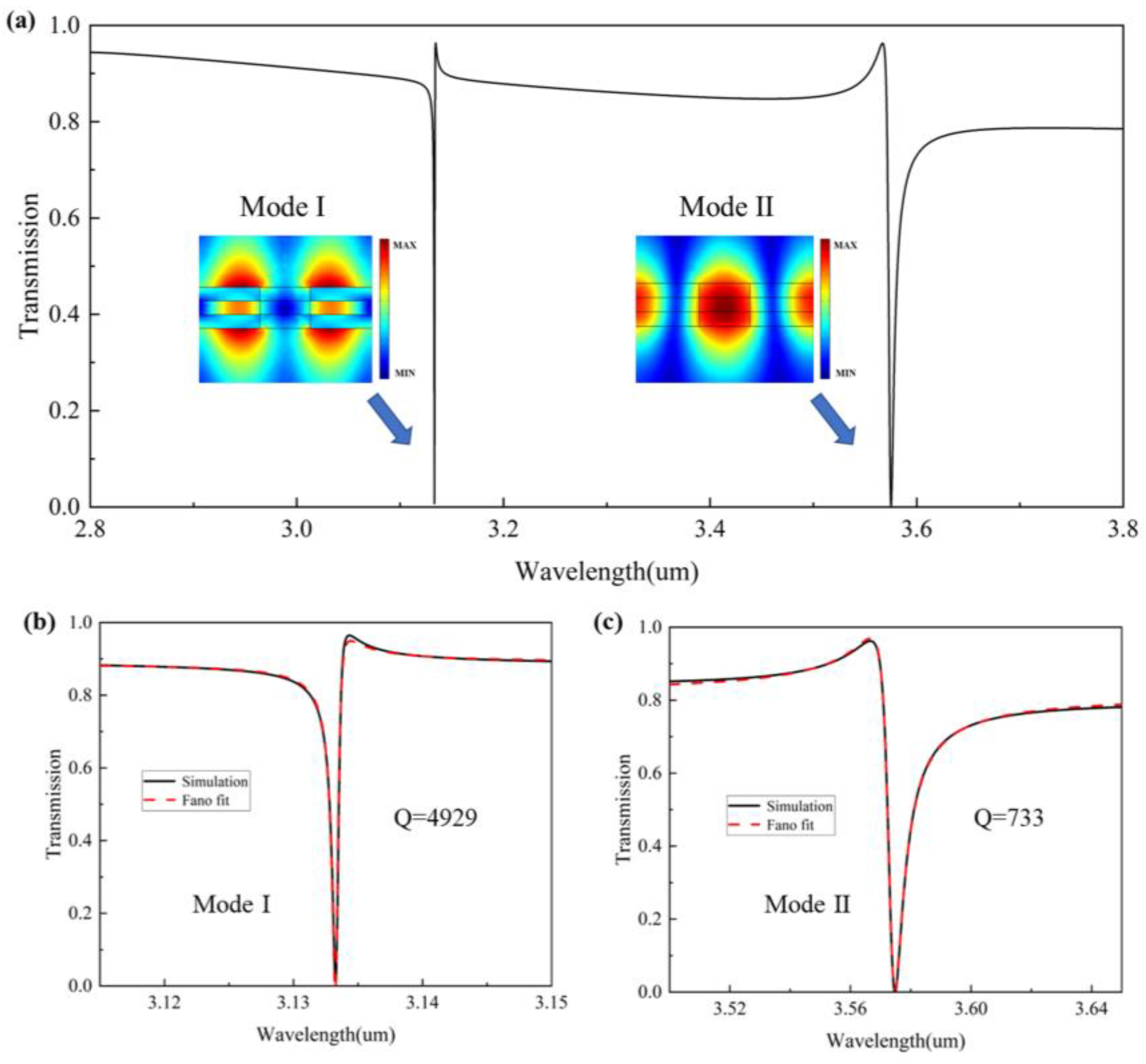
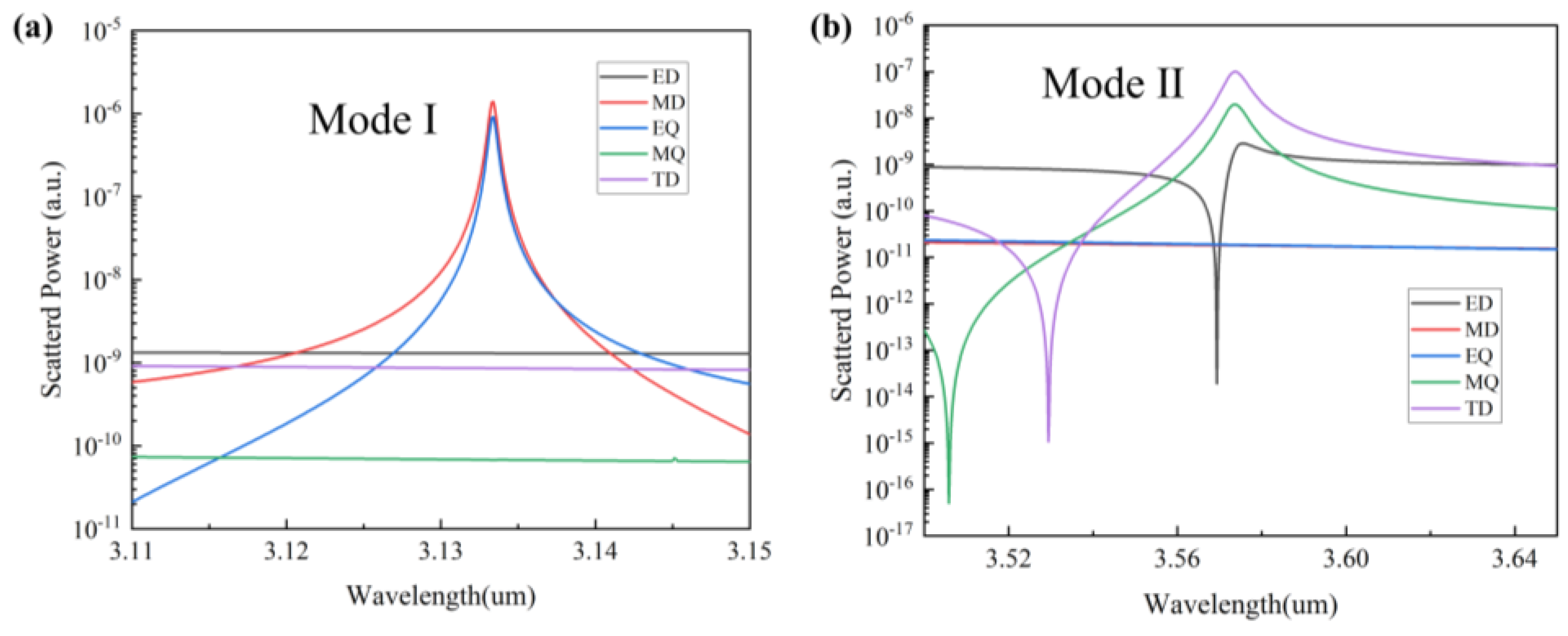
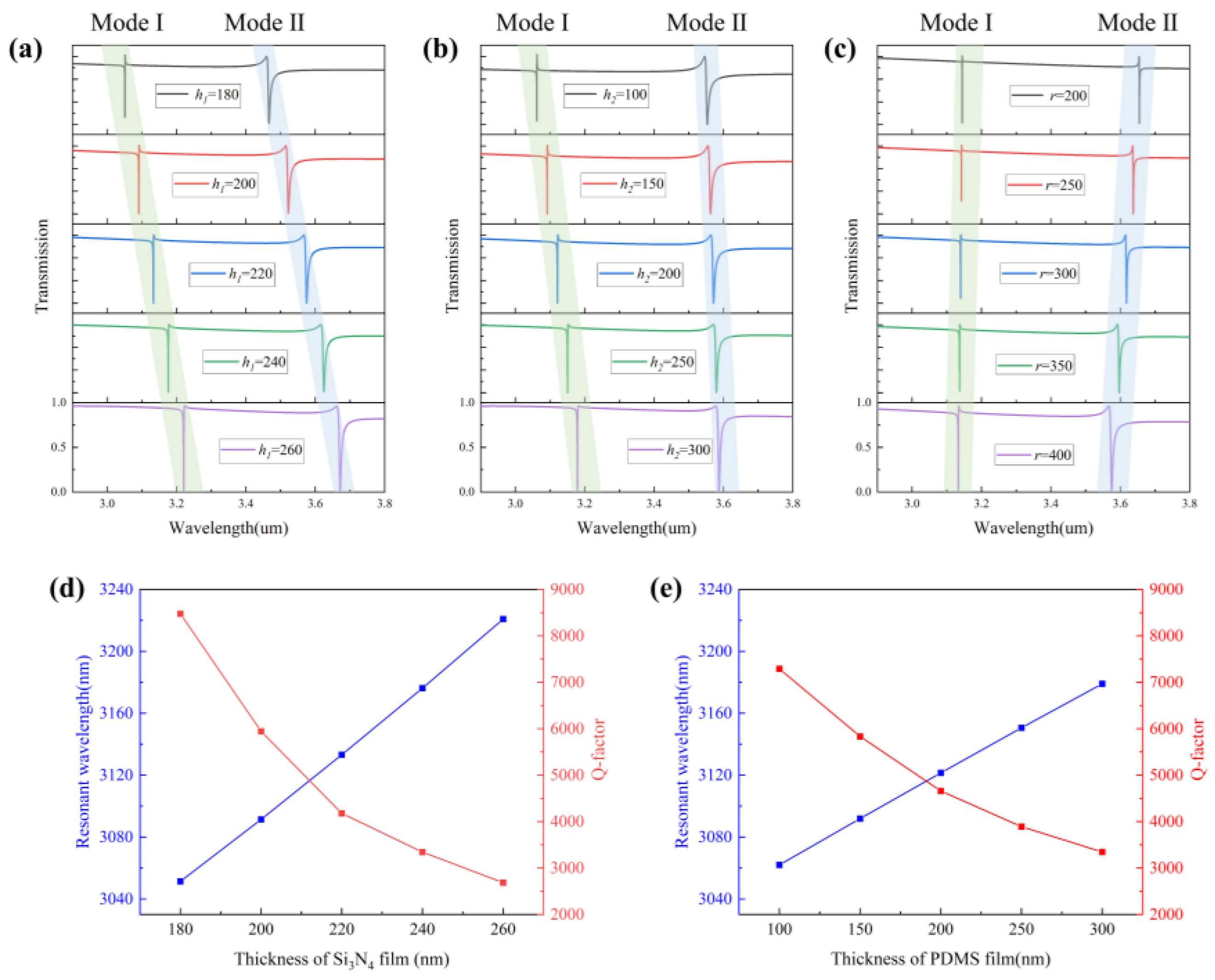
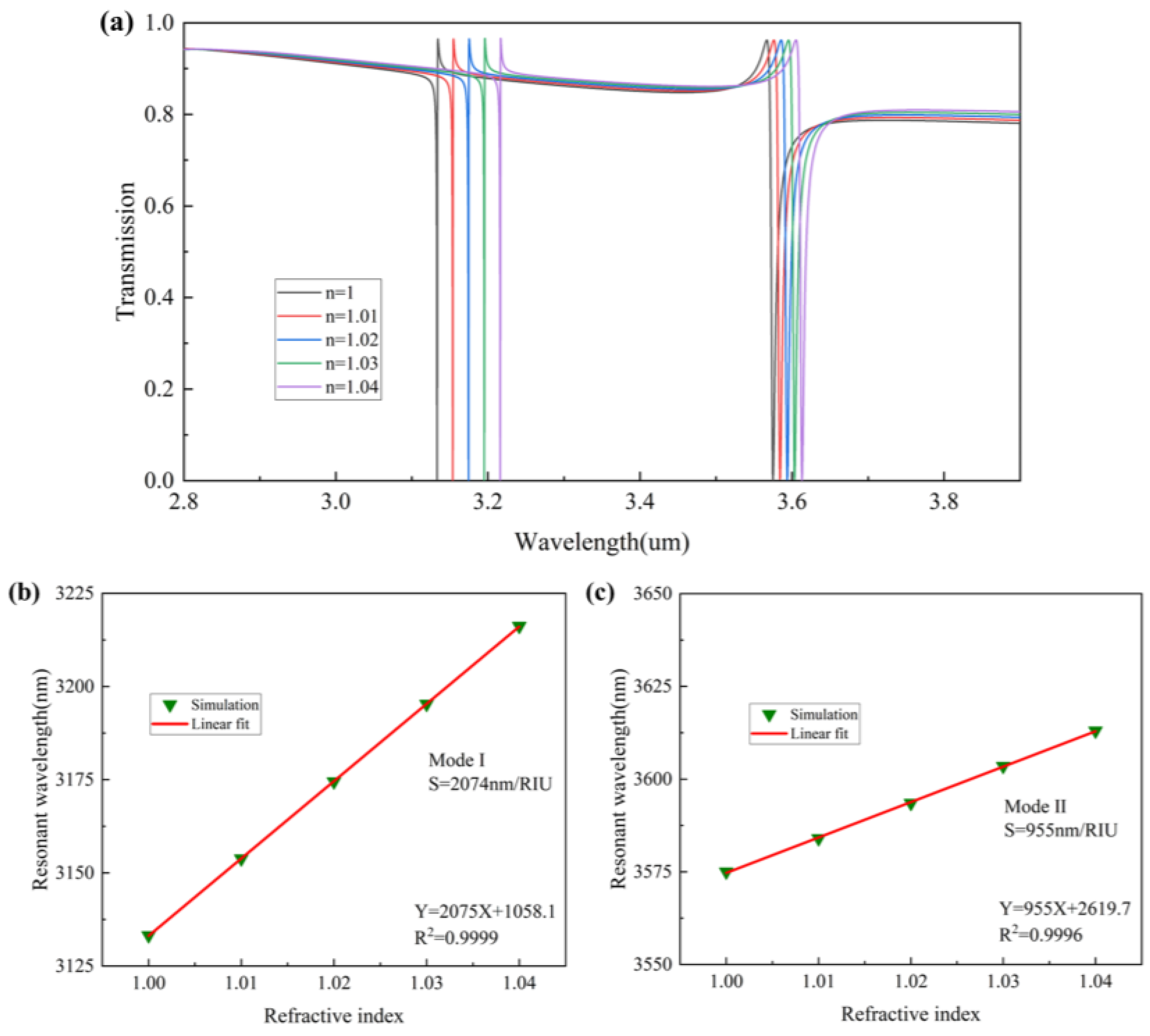
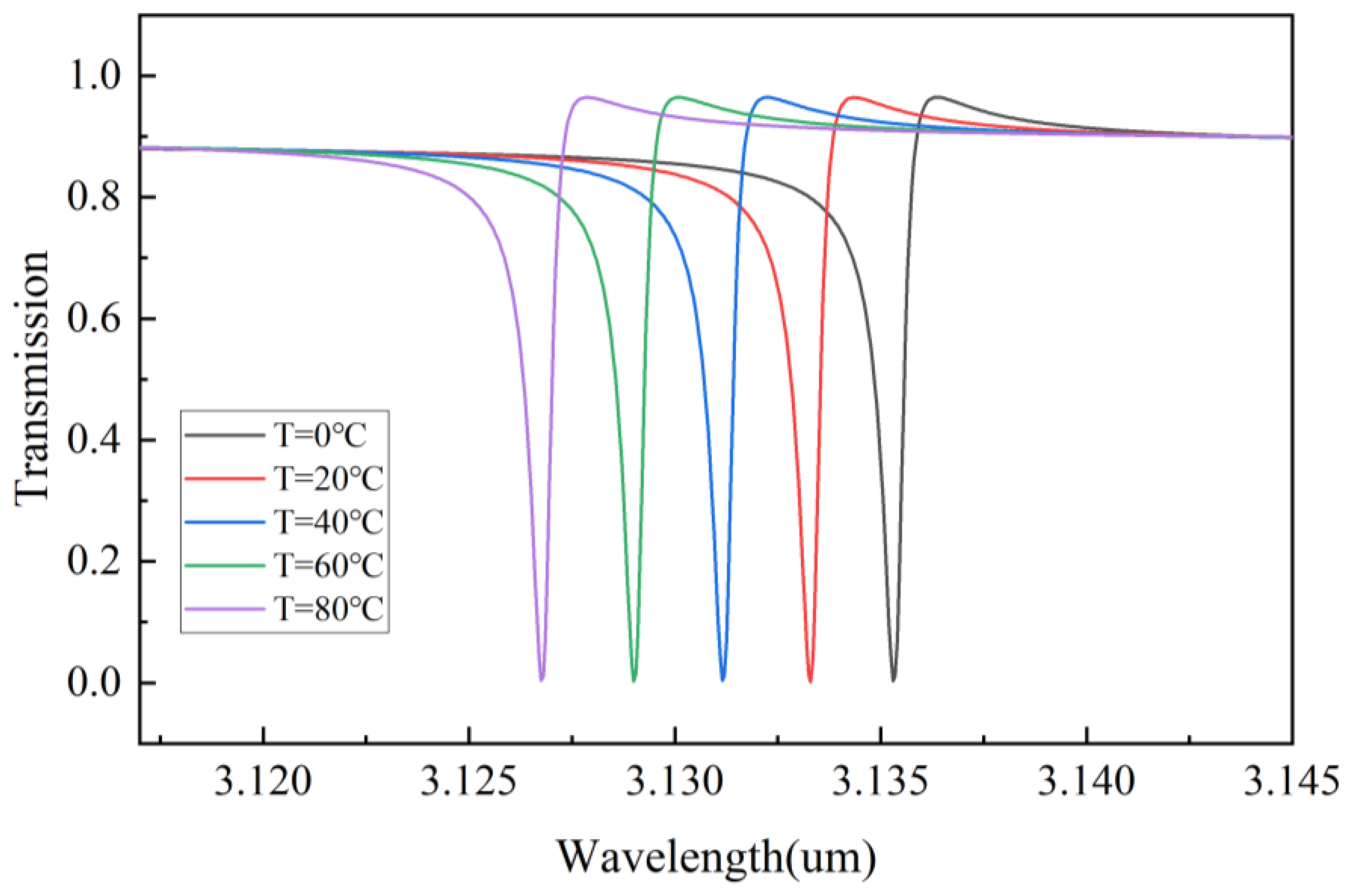
Disclaimer/Publisher’s Note: The statements, opinions and data contained in all publications are solely those of the individual author(s) and contributor(s) and not of MDPI and/or the editor(s). MDPI and/or the editor(s) disclaim responsibility for any injury to people or property resulting from any ideas, methods, instructions or products referred to in the content. |
© 2023 by the authors. Licensee MDPI, Basel, Switzerland. This article is an open access article distributed under the terms and conditions of the Creative Commons Attribution (CC BY) license (https://creativecommons.org/licenses/by/4.0/).
Share and Cite
Yao, W.; Zhou, Q.; Jing, C.; Zhou, A. A Mid-Infrared Multifunctional Optical Device Based on Fiber Integrated Metasurfaces. Nanomaterials 2023, 13, 2440. https://doi.org/10.3390/nano13172440
Yao W, Zhou Q, Jing C, Zhou A. A Mid-Infrared Multifunctional Optical Device Based on Fiber Integrated Metasurfaces. Nanomaterials. 2023; 13(17):2440. https://doi.org/10.3390/nano13172440
Chicago/Turabian StyleYao, Weikang, Qilin Zhou, Chonglu Jing, and Ai Zhou. 2023. "A Mid-Infrared Multifunctional Optical Device Based on Fiber Integrated Metasurfaces" Nanomaterials 13, no. 17: 2440. https://doi.org/10.3390/nano13172440



